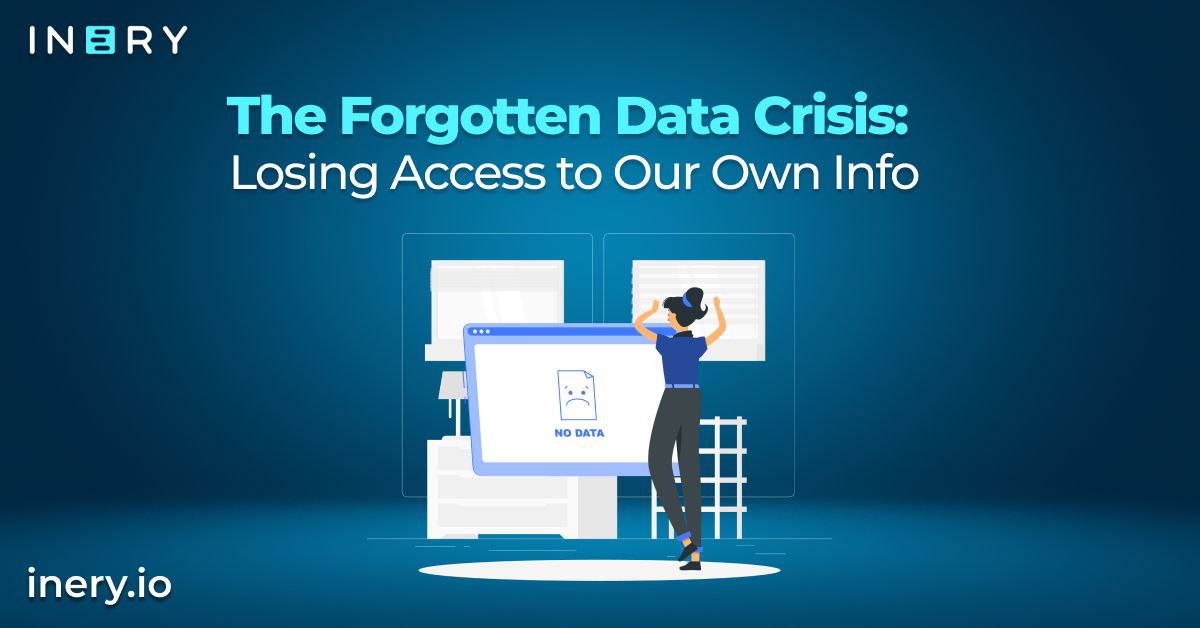If you want to feel slightly less safe about your digital life, try Googling “List of data breaches.” Don’t read the articles. Go straight to the Wikipedia page. Scroll down. Try not to panic.
What you’ll see is a catalog of companies, institutions, and governments that failed to protect the most personal parts of people’s lives: passwords, addresses, phone numbers, photos, medical history, bank accounts, and even their very identities.
Data leaks have become a grim routine. Some are small, others shake entire nations. But all of them have one thing in common: they didn’t have to happen. The fact that they did reveals just how much control we’ve handed over, and how little we’ve done to protect it.
As Inery’s cofounders often say, “Another day, another data breach.” It lands like a joke (sort of), but it’s really a warning. Most people have no idea how much of their data is being collected, where it goes, or who ends up with it.
Let’s look at five of the biggest breaches, and what we should have learned by now.
Yahoo (2013): The One That Broke the Record
It’s only fair if we start with the biggest.
In 2013, Yahoo was hit with a breach that would eventually affect every single one of its user accounts – three billion in total. The company first reported the breach in 2016, claiming one billion users were affected. A year later, they revised the number. The real count? All of them.
The stolen data included names, email addresses, phone numbers, dates of birth, and answers to security questions. While financial information wasn’t part of the leak, that didn’t stop the damage. Passwords were encrypted, but not securely enough.
To make it worse, Yahoo didn’t even know about the breach until three years later. When they did, it took a full year to admit how bad it really was. By then, the damage had long been done.
This wasn’t just a PR nightmare. It was a clear warning of what happens when systems grow too big to properly protect themselves, and too slow to admit they failed.
Facebook (2019–2021) Data Breach
In April 2019, researchers discovered that two datasets from Facebook apps had been exposed to the public. Together, they held personal information for over 530 million users across more than 100 countries.
This included Facebook IDs, names, phone numbers, and locations. No passwords this time. But still, think about it. Over half a billion phone numbers… just sitting there, waiting to be misused.
Two years later, in 2021, the entire dataset was posted online, for free. Security researcher Troy Hunt said it best: “I’d never planned to make phone numbers searchable... The Facebook data changed all that.”
You could now search your number to see if it was exposed. If that sounds like a useful feature, it’s only because the breach was so bad, so widespread, and so real, that millions needed to check whether their identity had been quietly compromised.
Microsoft Exchange (2021) Data Breach
At the beginning of 2021, Microsoft faced one of the most complex and dangerous breaches in U.S. history.
Hackers targeted vulnerabilities in Microsoft Exchange email servers, a.k.a. one of the most widely used corporate email systems in the world. By the time anyone realized what was happening, at least 30,000 organizations in the U.S. had been compromised. Globally, that number climbed to over 60,000.
The attackers exploited four different bugs to gain access to emails, launch malware, and leave backdoors open for future intrusions. Local governments, small businesses, law firms – they were all affected.
The problem? These were on-premise servers. Microsoft couldn’t patch them directly. Unless each organization acted fast, they were sitting ducks.
Weeks later, the U.S. government officially blamed China. Microsoft named the hacker group Hafnium. But assigning blame didn’t undo the breach. Emails were read. Systems were compromised. Trust was lost.
Aadhaar (2018) Data Breach
In India, Aadhaar is the closest thing to a national identity system. It holds biometric and demographic data for over a billion citizens. That includes names, addresses, phone numbers, fingerprints, iris scans.. Essentially everything.
In 2018, journalists revealed that this information could be accessed online—for less than $10.
Hackers had found a way in through a state-run utility company connected to the Aadhaar database. The company’s website had no access controls. None. That tiny opening was all it took to expose one of the world’s largest biometric databases.
The leak didn’t just reveal personal details. It opened the door to identity fraud, unauthorized financial access, and potential surveillance. And yet, for months, officials denied the breach was even real.
For everyday people, the fallout wasn’t theoretical. Imagine trying to apply for government aid or open a bank account, only to find that someone else had already done it in your name.
National Public Data (2024) Data Breach
You’ve probably never heard of a company called National Public Data. But in April 2024, you may have felt the effects of what happened to them.
This company runs background checks. It collects information from public records and sells it to other companies. That includes addresses, court records, phone numbers, and Social Security numbers.
Then it got hacked.
Over 270 million people were affected. Some of the data started appearing online in dark web forums. The rest was eventually dumped in full.
A breach this size doesn’t just mean embarrassment. It means real people are now dealing with phishing scams, identity theft, and financial fraud.
What’s worse is that many victims didn’t even know the company existed. They never signed up. They never gave permission. Their data was scraped, stored, and sold, until it wasn’t just stored. It was stolen.
What Ties These Disasters Together?
None of these breaches happened in the same way. Some involved poor coding. Others relied on human error, unprotected servers, or outdated infrastructure. But all of them share one root cause: too much data in one place.
Centralized systems are efficient. But when they break, they break hard. They invite attackers by offering exactly what they want: a giant vault filled with sensitive information.
When the walls come down, it’s not just usernames and passwords on the floor. It’s lives.
Why Decentralization Has to Be the Future
We’ve reached a point where good intentions and a decent IT team aren’t enough. What’s needed is a different structure.
Decentralized systems take the central target away. Instead of one big vault, there are many smaller, independent vaults that work together. There’s no single point of failure. And even if someone breaks into one, they don’t get the whole picture.
This is exactly what Inery is building. A decentralized, high-performance data management system that separates metadata from raw data, uses distributed consensus instead of centralized control, and gives users real power over how their information is stored.
It’s not a magic solution. It’s just smarter. More intentional. And built for a world where mistakes don’t just cost money anymore. They cost people.
Conclusion
The breaches we’ve seen so far are only the ones we know about. Others are happening now, buried in inboxes and forgotten folders. The real danger isn’t in one password leaking. It’s in the millions of people thinking it won’t happen to them.
If your information is stored in a centralized system, it’s not a question of if something will go wrong. It’s just a matter of when.
There’s still time to do things differently. We just have to stop trusting systems that were never built to keep us safe and start creating ones that are.

Inery•
3 years ago
Inery: Transcending IPFS with True Decentralization
Moving beyond the IPFS and database storage solution to offer a database management solution in a decentralized architecture. ...READ MORE

Share

Inery•
4 months ago
What is Data Streaming?
Data streaming moves information as it’s created, enabling real‑time insights and actions. Learn how it works and why Inery makes it reliable. ...READ MORE

Share

Inery•
5 months ago
The Paradox of Security Measures: Why More Isn't Always Better
More security isn't always better. Learn about the hidden risks of complicated security systems and see how Inery provides effective protection without unnecessary complexity. ...READ MORE

Share

Inery•
9 months ago
How to Handle Data Growth Pains
Data growth is inevitable, but chaos doesn’t have to be. Learn how businesses can manage expanding databases without sacrificing performance, security, or IT sanity. ...READ MORE

Share
Most popular today



